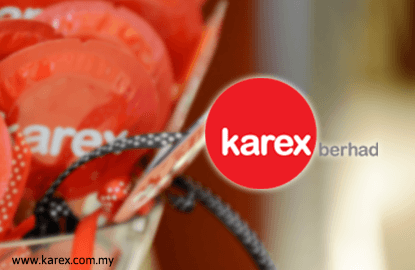
This article first appeared in Corporate, The Edge Malaysia Weekly, on June 6 - 12, 2016.
OVER the last two years, Karex Bhd, the world’s largest condom maker, has made a string of acquisitions to expand its business. This raises the question: Was it necessary for Karex to spend about RM60 million to acquire the companies?
Karex is an original equipment manufacturer (OEM) for about 90 brands, including Durex. Its venture into making its own condom, Carex, has been costly and resource consuming, admits CEO Goh Miah Kiat.
“It is not easy to build a brand. In Malaysia, there is no company that can say it has a global brand. A lot of resources are needed to grow a brand,” Goh tells The Edge.
Still, he wants to do just that, believing that it will fatten margins in the future.
He decided that Karex should acquire companies with established brands and distribution and marketing channels. It started with a 55% equity stake in Global Protection Corp, for which it paid US$6.6 million (RM21.54 million), in 2014. Boston-based Global Protection owns and distributes ONE Condoms in the US.
In January, Karex bought certain assets from TheyFit LLC for US$1.3 million (RM5.64 million). TheyFit sells made-to-measure condoms.
On May 27, the company announced a proposal to take over UK-based Pasante Healthcare Ltd for £6 million (RM36 million).
Why OBM?
The strategy to enter the own brand manufacturing (OBM) segment was because, as an OEM, Karex gets three US cents from each piece of condom that the consumer buys at US$1. The biggest chunk of the selling price goes to the brand owner, says Goh. Out of every US dollar paid by the consumer, 30 US cents goes to the brand owner, he explains.
He aims to have the OBM business contribute 20% of sales in five years’ time.
In addition to enhancing its earnings, Karex is expanding its OBM business because its operating margin is under pressure. It shrank to around 12% in the third quarter ended March 31, 2016 (3QFY2016) from 23% in the previous corresponding period.
Karex’s net profit in the nine months ended March 31, 2016 (9MFY2016), grew to RM54.6 million, up 28% from the previous corresponding period. However, its net profit in 3QFY2016 plunged 35% year-on-year, owing to the stronger ringgit, which appreciated 9% against the US dollar to 3.90, resulting in a foreign exchange loss of RM5.9 million for the quarter.
It was a different scenario a year ago. Karex’s profit before tax of RM73.9 million for FY2015 was boosted by RM10.07 million in foreign exchange gains, as the ringgit had fallen 17.7% during the financial year.
The weaker earnings have exerted selling pressure on Karex’s share price, which tumbled from a record high of RM3.13 early this year to RM2.23 last Thursday.
Will the investments be justified?
According to Goh, the group does not expect meaningful income contribution from Global Protection soon but expects Pasante to contribute in the near future.
“Karex acquired 55% of Global Protection to grow its OBM segment. The exclusive distribution agreement in particular provided us with a platform to launch a global brand in ONE Condoms. As such, the financial impact of this acquisition has been minimal and will continue to be so for a few years until the brand begins to develop and gain traction in the region, beginning with the Malaysian launch last December,” says Goh.
Pasante was not a customer of Karex, but it has a dominant position in the UK’s National Health Service (NHS) tender market. Goh estimates that Pasante supplies 85% of the condoms procured by the NHS.
“Immediately, this highlights the synergy in being able to switch the supply to Karex’s own facilities. While the financial figures remain sensitive, we feel this acquisition will be able to contribute positively in the near future,” says Goh.
Global Protection provides Karex access to the tender business in the US. According to Goh, Global Protection has the leading market share in the tender segment there.
“The tender segment is most important. If you look at the condoms business, 50% of the world’s condoms today are purchased through governments. People in certain areas cannot afford to buy condoms. So, it is the governments’ responsibility to distribute condoms for free to the public,” he says.
The tender market enables Karex to distribute its branded condoms, especially ONE Condoms, through the hundreds of NHS clinics in the UK as well as hospitals in the US. As anyone can walk into any of the clinics or hospitals and get access to free or highly-subsidised condoms, the ONE Condoms will gain visibility.
In the US, 30% of all condoms are distributed by the state, while in the UK, anybody below the age of 25 has access to free condoms through the NHS, explains Goh.
Also, agencies such as the United Nations and the United States Agency for International Development procure condoms to be distributed for free in countries with high HIV prevalence rates.
As at 3QFY2016, 40% of Karex’s condoms were sold through the tender market, with the commercial market taking up a 53% share. The OBM segment contributed only 7% of Karex’s condoms supply.
Karex has chalked out its course of action — to grow both the OBM and tender segments. Now, Goh has to ensure that the invested money works hard to generate lucrative returns to justify the valuation of its share price at a price-earnings ratio of over 30 times.
Save by subscribing to us for your print and/or digital copy.
P/S: The Edge is also available on Apple's AppStore and Androids' Google Play.